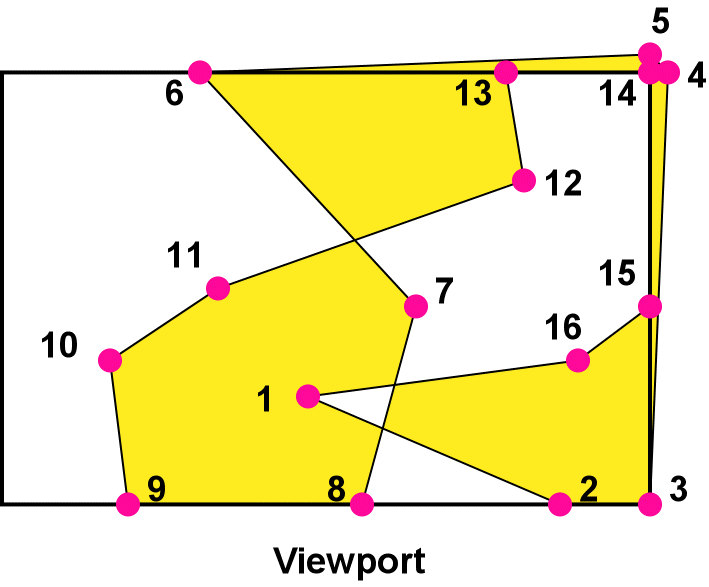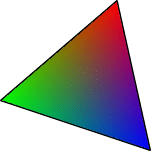CS 184: COMPUTER GRAPHICS
QUESTION OF THE DAY:

|
Given a complex polygon that we want to shade based on the non-zero winding number paradigm.
Let's assume that we have already clipped that
polygon properly to the bounds of the viewport.
Now we need an
efficient way to rasterize this polygon, i.e., to turn on all the
pixels in the viewport that fall inside the polygon.
Think of a good
algorithm and estimate its complexity.
|
PREVIOUS
< - - - - > CS
184 HOME < - - - - > CURRENT
< - - - - > NEXT
Lecture #4 -- Mon 2/2/2009.
Polygon Rasterization
Crucial Concepts from Last Lecture:
Several possible definitions of "INSIDE":
1.) "PARITY" -- "EX-OR" -- "ON-OFF": Switch between IN and OUT every time one steps across a single contour edge.
2.) "Non-zero Winding Number": The polygon contour, seen as a
string loop cannot be pulled away from a finger stuck at an INSIDE
point.
3.) "Positive (non-zero)
Winding Number": INSIDE is true if the loops of the oriented
contour caught around probe point (finger) travel in CCW direction.
(This is the preferred paradigm in computer graphics and for rapid prototyping by layered manufacturing.)
To compute the WINDING NUMBER:
Count ONE UP or ONE DOWN depending on whether the oriented contour edge
that one crosses comes from the LEFT or from the RIGHT.
It is desirable to consider the orientation of a polygon contour so we can do BACKFACE ELIMINATION (and save roughly half the work in the rendering pipeline).
ALL GEOMETRY should be clipped to the viewport frame!
Clipping of lines and polygons is straight-forward and is now done by the graphics hardware;
it preserves the visible portion inside the viewport and the topological information needed for rendering.
Linear interpolation is a key operation not just for clipping,
but also for morphing, for shading, and for the efficient calculation of splines and
subdivision surfaces.
The Various Coordinate Systems in the Classical Rendering Pipeline:
World
to screen transforms - Overview
(This is valid in some form for all rendering environments).
Algorithm for Polygon Rasterization
Let's asume we have done a suitable transformation to bring our
polygon into a normalized viewing volume where we just have to do a
simple parallel projection along the z-axis (equal to setting z equal
to zero) to get the desired display of the polygon.
Now -- how can we determine in an efficient manner WHICH PIXELS should be turned on ?
refer to: DISCUSSION OF THE QUESTION OF THE DAY.
We "turn on" all the pixels that have a sampling point that
falls inside the polygon contour.
Now we want to implement a rasterization algorithm in an efficient manner:
Sweeping Scan-line Approach
First we do this one polygon at a time. (not explained well enough in [Shirley]).
Datastructures:
-- Scene Graph -- Display List -- Edge Table
-- Active Edge List.
Preprocessing:
-- Bucket-sort (in y) all polygon edges into the Edge Table.
Process the scan-line buckets from bottom to top.
-- Inserting
edges into scan-line buckets (details)
Scan-line Processing:
-- For the current swath of pixels update the Active Edge List of all edges that cross the current scan line.
-- Details
of scan-line processing on active edge list
-- Turn on pixesl that have their sampling points on active inside spans.
(For convenience we chose
the pixel sampling point to be the lower left corner, thus avoiding to
have to add/subtract 0.5 all the time.)
Gouraud Shading (= linear interpolation between vertices)
In addition to the above, let's now assume that the polygon to be shaded is just a simple triangle.
It is normally a good idea to break complicated polygons into
triangles, then you know what you have got; different renderers may do
different (and sometimes strange) things to a concave, non-planar
polygon.
However, it is still important to understand the winding number
paradigm and to use it where appropriate, e.g. in layered
manufacturing. There the machine needs to calculate for each layer of
material deposited the exact polygon to be "painted in."

But now we want to give this triangle a smoothly changing color;
where three different colors have been specified for its three
vertices.
To determine the color of any point inside the triangle, we will use barycentric coordinates.
(The influence of a vertex diminishes proportional to the distance from
the opposite side.) This can easily be calulated with linear
interpolation. A practical way to do this is to interpolate first along
the edges of the triangle and then along the scan line between the
previously calculated values on the edges.
Z-buffer Algorithm (to find the "top" visible polygon)
Now, in addition to the above, we assume that we have several
triangles which partially overlap in the projection into our viewport (and perhaps even intersect in 3D).
How do we determine efficiently which triangle a particular pixel should represent?
The z-buffer is a 2D array of storage elements that stores for each
pixel (R,G,B)color and a z-depth.
-- Paint all triangles (one at a time) into the
z-buffer (using scan-line-based raster filling);
-- the front-most pixel and its depth and color
will be retained -- and finally displayed.
-- The z-depth of each pixel can be efficiently
calculated by linear interpolation,
i.e., by fixed incrementation
in y and in x (since we assume all polyhedron faces to be planar).
Linear Interpolation in Scan-Line Algorithm
Alternative Scan-line Approach: Processing all polygons simultaneously
Differences to basic approach above if there is no z-buffer available: Exploit linearity and coherence as much as possible!
Extra
Notes on Sweep-Line-Based Hidden Feature Elimination
The devil is in the details !
Dealing with possible coincidences needs all the attention (and produces most of the bugs).
Here is a more detailed description of a sweeping
scan-line algorithm.
Reading Assignments:
Study: ( i.e., try to understand fully, so that you can answer
questions
on an exam):
Shirley, 2nd Ed: Ch 3.6-3.7; Ch 17.1-17.2.
Programming Assignments 1 and 2:
Both must be done individually.
Assignment #1 is due (electronically submitted) before Thursday 2/5, 11:00pm.
Assignment #2 is due (electronically submitted) before Thursday 2/12, 11:00pm.
PREVIOUS
< - - - - > CS
184 HOME < - - - - > CURRENT
< - - - - > NEXT
Page Editor: Carlo
H. Séquin
